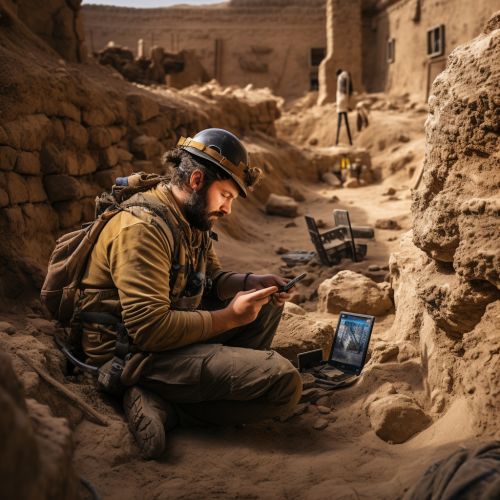Digital Archaeology
Introduction
Digital Archaeology refers to the use of digital tools and methods to study, interpret, and preserve artifacts, sites, and monuments related to human history. This field is a sub-discipline of archaeology and is closely related to computational archaeology, virtual archaeology, and cyber-archaeology.


History and Development
The emergence of Digital Archaeology can be traced back to the late 20th century, coinciding with the advent of computer technologies. The first instances of digital technology in archaeology were seen in the 1960s, with the use of mainframe computers to process archaeological data. However, the term "Digital Archaeology" was not coined until the 1990s, when archaeologists started using personal computers and software for archaeological research.
Digital Tools and Techniques
Digital Archaeology employs a variety of digital tools and techniques, including Geographic Information Systems (GIS), 3D modeling, remote sensing, digital photogrammetry, and virtual reality (VR). These tools and techniques allow archaeologists to collect, analyze, and interpret archaeological data in ways that were not possible with traditional methods.
Geographic Information Systems
GIS is a digital tool that allows archaeologists to capture, store, manipulate, analyze, and present spatial and geographic data. This tool is particularly useful in archaeological site prospection and landscape archaeology.
3D Modeling
3D modeling is a technique used in Digital Archaeology to create a three-dimensional digital representation of an archaeological artifact or site. This technique allows archaeologists to study and analyze artifacts and sites in detail without physically handling or disturbing them.
Remote Sensing
Remote sensing is a technique used in Digital Archaeology to collect data about an archaeological site from a distance. This technique includes methods such as aerial photography, satellite imagery, and ground-penetrating radar.
Digital Photogrammetry
Digital photogrammetry is a technique used in Digital Archaeology to create 3D models of artifacts and sites from photographs. This technique is particularly useful in documenting and preserving archaeological sites.
Virtual Reality
VR is a digital tool that allows archaeologists to create immersive, interactive 3D environments of archaeological sites. This tool is particularly useful in public archaeology and education, as it allows the public to experience archaeological sites in a way that is not possible with traditional methods.
Applications
Digital Archaeology has a wide range of applications, from archaeological research and site management to public archaeology and education. Some of the key applications of Digital Archaeology include:
Archaeological Research
Digital tools and techniques allow archaeologists to collect, analyze, and interpret archaeological data in new and innovative ways. For example, GIS can be used to analyze spatial patterns in archaeological sites, while 3D modeling can be used to study and analyze artifacts in detail.
Site Management
Digital Archaeology can also be used for site management, including site mapping, monitoring, and preservation. For example, remote sensing can be used to identify and map archaeological sites, while digital photogrammetry can be used to document and preserve sites.
Public Archaeology and Education
Digital Archaeology can also be used to engage the public and educate them about archaeology. For example, virtual reality can be used to create immersive, interactive 3D environments of archaeological sites, allowing the public to experience these sites in a unique and engaging way.
Challenges and Criticisms
Despite its many benefits, Digital Archaeology also faces several challenges and criticisms. One of the main challenges is the digital divide, which refers to the gap between those who have access to digital technologies and those who do not. This divide can limit the use and effectiveness of digital tools and techniques in archaeology.
Another challenge is the issue of data preservation. Digital data is vulnerable to loss and degradation, and preserving this data for future generations is a major concern in Digital Archaeology.
Criticisms of Digital Archaeology often focus on its reliance on technology and the potential for this reliance to overshadow traditional archaeological methods and skills. Some critics also argue that Digital Archaeology can be too focused on data collection and analysis, at the expense of interpretation and understanding.
Future Directions
The future of Digital Archaeology is likely to be shaped by advances in technology and the continued integration of digital tools and techniques into archaeological practice. Potential future directions for Digital Archaeology include the increased use of artificial intelligence and machine learning in data analysis, the development of new digital tools and techniques, and the continued growth of public archaeology and education through digital means.
